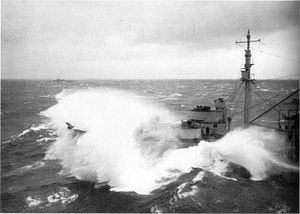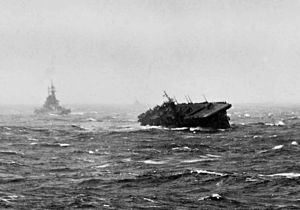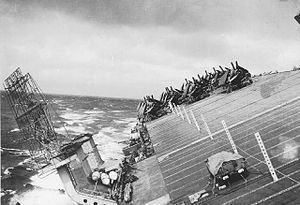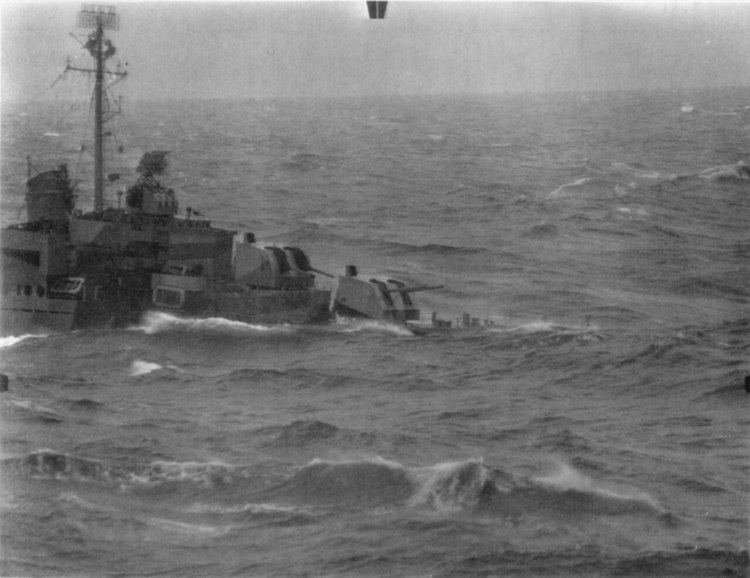Formed December 14, 1944 | Dissipated December 19, 1944 Highest wind speed 220 km/h Fatalities 790 | |
 | ||
Highest winds Gusts: 220 km/h (140 mph) Lowest pressure ≤ 907 hPa (mbar); 26.78 inHg Date 14 December 1944 – 18 December 1944 | ||
005 typhoon cobra dec 1944
Typhoon Cobra, also known as the Typhoon of 1944 or Halsey's Typhoon (named after Admiral William 'Bull' Halsey), was the United States Navy designation for a tropical cyclone that struck the United States Pacific Fleet in December 1944 during World War II.
Contents
- 005 typhoon cobra dec 1944
- Task force in typhoon cobra near philippine islands 12 20 1944 full
- Meteorological history
- Task Force 38
- 3rd Fleet damage
- Rescue efforts
- Investigation
- References

Task Force 38 (TF 38) had been operating about 300 mi (260 nmi; 480 km) east of Luzon in the Philippine Sea, conducting air raids against Japanese airfields in the Philippines. The fleet was attempting to refuel its ships, especially the lighter destroyers, which had small fuel tanks. As the weather worsened it became increasingly difficult to refuel, and the attempts had to be discontinued. Despite warning signs of worsening conditions, the ships remained in their stations. Worse, the information given to Halsey about the location and direction of the typhoon was inaccurate. On December 17, Halsey unwittingly sailed Third Fleet into the heart of the typhoon.

Because of 100 mph (87 kn; 45 m/s; 160 km/h) winds, very high seas and torrential rain, three destroyers capsized and sank, and 790 lives were lost. Nine other warships were damaged, and over 100 aircraft were wrecked or washed overboard; the aircraft carrier Monterey was forced to battle a serious fire that was caused by a plane hitting a bulkhead.

USS Tabberer—a small John C. Butler-class destroyer escort—lost her mast and radio antennas. Though damaged and unable to radio for help, the ship remained on the scene to recover 55 of the 93 total sailors who were rescued. Captain Henry Lee Plage earned the Legion of Merit, while the entire crew earned the Navy's Unit Commendation Ribbon, which was presented to them by Halsey.

In the words of Admiral Chester Nimitz, the typhoon's impact "represented a more crippling blow to the Third Fleet than it might be expected to suffer in anything less than a major action". The events surrounding Typhoon Cobra were similar to those the Japanese navy itself faced some nine years earlier in what they termed the "Fourth Fleet Incident."

This typhoon also led to the establishment of weather infrastructure of the US Navy, which eventually became the Joint Typhoon Warning Center.

A typhoon plays an important role in the novel The Caine Mutiny, which is thought to be based on the author's own experience surviving Typhoon Cobra.
Task force in typhoon cobra near philippine islands 12 20 1944 full
Meteorological history
On December 17, the typhoon was first observed, surprising a fleet of ships in the open western Pacific Ocean. Barometric pressures as low as 26.8 inHg (907 mbar) and wind speeds up to 120 kn (140 mph; 62 m/s; 220 km/h) in gusts were reported by some ships. The storm was last seen on the 18th.
Task Force 38
TF 38 consisted of seven fleet carriers, six light carriers, eight battleships, 15 cruisers, and about 50 destroyers. The carriers had been conducting raids against Japanese airfields in the Philippines and ships were being refueled, especially many destroyers running low on fuel. When the storm hit, the procedure had to be aborted.
Damage to the fleet was severe. Some ships rolled more than 70 degrees. Three destroyers, Spence, Hickox, and Maddox, had nearly empty fuel stores (10-15% of capacity) and therefore lacked the stabilizing effect of the extra weight and thus were relatively unstable. Additionally, several other destroyers, including Hull and Monaghan, were of the older Farragut-class and had been refitted with over 500 long tons (510 t) of extra equipment and armament which made them top-heavy.
Spence, Hull, and Monaghan either capsized or were sunk after water flooded down their smokestacks and disabled their engines. Without power, they were unable to control their heading and were at the mercy of the wind and seas. Hickox and Maddox pumped seawater into their empty fuel tanks, adding enough stability to ride out the storm with relatively minor damage.
Many other ships of TF 38 suffered various degrees of damage, especially to radar and radio equipment which crippled communications within the fleet. Several carriers suffered fires on their hangars and 146 aircraft were wrecked or blown overboard. Nine ships— including one light cruiser, three light carriers, and two escort carriers—suffered enough damage to be sent for repairs.
The carrier Monterey was nearly taken down in flames by its own airplanes as they crashed into bulkheads and exploded during violent rolls. One of those fighting the fires aboard Monterey was then-Lt. Gerald Ford, later President of the United States. Ford later recalled nearly going overboard; when 20° and greater rolling caused aircraft below decks to careen into each other, igniting a fire. Ford, serving as General Quarters Officer of the Deck, was ordered to go below to assess the raging fire. He did so safely, and reported his findings back to the ship's commanding officer, Captain Stuart Ingersoll. The ship's crew was able to contain the fire, and the ship got underway again.
3rd Fleet damage
Rescue efforts
The fleet was scattered by the storm. One ship, the destroyer escort Tabberer, encountered and rescued a survivor from Hull while itself desperately fighting the typhoon. This was the first survivor from any of the capsized destroyers to be picked up. Shortly thereafter, many more survivors were picked up, in groups or in isolation. Tabberer's skipper—Lieutenant Commander Henry Lee Plage—directed that the ship, despite its own dire condition, begin boxed searches to look for more survivors.
Tabberer eventually rescued 55 survivors in a 51-hour search, despite repeated orders from Admiral Halsey to return all ships to port in Ulithi. She picked up 41 men from Hull and 14 from Spence before finally returning to Ulithi after being directly relieved from the search by two destroyer escorts.
After the fleet had regrouped (without Tabberer), ships and aircraft conducted search and rescue missions. The destroyer Brown rescued the only survivors from Monaghan, six in total. She additionally rescued 13 sailors from Hull. Eighteen other survivors from Hull and Spence were rescued over the three days following Typhoon Cobra by other ships of the 3rd Fleet. The destroyer USS The Sullivans (DD-537) emerged from the storm undamaged and began looking for survivors before returning to Ulithi on Christmas Eve. In all, 93 men were rescued of the over 800 men presumed missing in the three ships, and two others who had been swept overboard from the escort carrier Anzio.
Despite disobeying fleet orders, Plage was awarded the Legion of Merit by Admiral Halsey, and Tabberer's crew each were awarded Navy Unit Commendation ribbons (the first ever awarded).
Investigation
While conducting refuelling operations off the Philippines, the Third Fleet remained on station rather than breaking up and seeking shelter from the storm. This led to a severe loss of men, ships, and aircraft. A Court of Inquiry was convened on board the USS Cascade at the Naval base at Ulithi, in the Caroline Islands, with Admiral Nimitz, CINCPAC, in attendance at the court. Forty-three-year-old Captain Herbert K. Gates was the Judge Advocate for the court. The Court found that though Halsey had committed an "error of judgement" in sailing the Third Fleet into the heart of the typhoon, it stopped short of unambiguously recommending sanction.
In January 1945, Halsey passed command of the Third Fleet to Admiral Spruance, whereupon its designation was changed to "Fifth Fleet".
Halsey resumed command in late May 1945. After a few days, in early June 1945, Halsey again sailed the fleet into the path of a typhoon, designated Connie, resulting in six lives lost, and 75 airplanes destroyed, with 70 more planes badly damaged. While ships sustained crippling damages, none were lost on this occasion. A Court of Inquiry was convened once again. After lengthy deliberations, the Court suggested that Halsey be "reassigned," but Admiral Nimitz rejected the Court's suggestion due to Halsey's "prior service" to the Navy. Halsey remained in command of the Third Fleet for approximately eight more weeks, until the cessation of hostilities on August 14, 1945. He was promoted to Fleet Admiral on December 11, 1945 and retired in March 1947.
